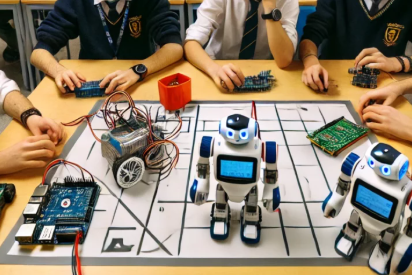Robotica Educativa: costruzione e programmazione di robot
Institution
Liceo Scientifico “G. Marconi” di Perugia
Institution Typology
School
Country
Italy
Stakeholders involved
Teachers: Science, mathematics, technology, and computer science educators
Students: High school students of the scientific curriculum
Families: Support and participation in school activities
Local Institutions: Logistical and organizational support
Summary
The project introduced students to building and programming robots using advanced kits such as Arduino and Raspberry Pi. Activities included participation in robotics competitions, enhancing skills in problem-solving and collaboration.
CONTEXT AND OBJECTIVES
Problem addressed or learning needs
The integration of coding and digital technologies into humanities subjects aims to:
Develop computational thinking: the ability to solve problems algorithmically.
Stimulate critical and creative thinking: analyzing and tackling challenges innovatively.
Improve learning in curricular subjects: applying technologies to deepen understanding in the humanities.
Promote collaborative work: developing social and teamwork skills.
Types of enhanced competences
Cognitive Skills: Acquisition of technical and theoretical knowledge
Metacognitive Skills: Reflection on one’s own learning process
Collaborative Skills: Ability to work in groups and communicate effectively
METHODS, STRATEGIES AND TOOLS
Subjects involved
Humanities, Technologies\Engineering, Math, Natural Science
Duration and timeline of implementation
The project spanned an entire school year, with weekly meetings and intensive laboratory activities.
Strategies and activities
Robot Design and Construction: Use of kits like Arduino and Raspberry Pi to build functional models
Programming: Writing code to control robots and perform specific tasks
Participation in Competitions: Team challenges to apply acquired skills in real-world scenarios
Material Sources
Hardware: Arduino kits, Raspberry Pi, sensors, motors
Software: Programming environments like Scratch, Python, and specific IDEs for Arduino and Raspberry Pi
Methodology
Team Work, Cooperative Learning, Learning By Doing
IMPACT AND RESULTS
Impact
Students Involved: Around 100 actively participating students
Teachers Involved: 5 coordinating teachers
Schools Involved: 1 school, with the potential to replicate the project in other institutions
Observed Benefits
Development of technical skills: practical knowledge in robotics and programming
Stimulated critical and creative thinking: ability to tackle challenges innovatively
Improved collaborative abilities: enhanced teamwork and communication
Increased interest in STEM subjects: higher student motivation and engagement
Challenges Faced
Resource Management: Need for adequate tools and specific teacher training
Adapting to Student Diversity: Customizing activities to meet individual learning needs
LESSONS LEARNT AND RECOMMENDATIONS
Key Success Factors
Integration of technologies: use of advanced tools to facilitate learning
Teacher collaboration: coordination among different disciplines for an interdisciplinary approach
Active student participation: direct involvement in hands-on activities and competitions
Future Improvements
Expansion of Resources: Acquisition of new kits and technology upgrades
Ongoing Teacher Training: Regular updates to maintain teaching quality
Family Involvement: Increased family participation in school activities
Recommendations
Project Replicability: Adapt the model for use in other schools to spread best practices
Sustainability: Seek funding and partnerships to ensure project continuity
Inclusiveness: Design activities that engage all students, regardless of their initial skill level

